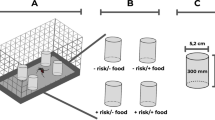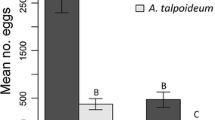Abstract
Invasive alien species can act as ‘evolutionary traps’ for indigenous parasites and predators when the alien species is accepted as prey or a host but is unsuitable for consumption or development. We tested the relationship between acceptance and suitability of eggs of the invasive alien Halyomorpha halys (Hemiptera: Pentatomidae) in North America relative to eggs of the indigenous Podisus maculiventris (Pentatomidae) for the indigenous generalist egg parasitoid Telenomus podisi (Hymenoptera: Scelionidae). T. podisi accepted 0–24 h old H. halys eggs at a rate similar to P. maculiventris eggs (87.5 ± 6.0 and 70.2 ± 9.1 %, respectively). Successful development of T. podisi occurred in 98.3 % of attacked P. maculiventris eggs, but was not observed in H. halys eggs. Oviposition by T. podisi did, however, reduce the developmental success of H. halys embryos relative to unattacked controls by 24.1 % in 0–24 h old eggs and 29.6 % in 24–48 h old eggs. We suggest that as H. halys spreads and increases in abundance in North America, it could operate as an evolutionary trap for indigenous egg parasitoids, thereby indirectly causing an increase in population levels of indigenous pentatomids. This predicted indirect effect would be a result of H. halys eggs acting as an egg sink for T. podisi. We also introduce the concept of a ‘time sink’, which may be particularly relevant for parasitoids such as T. podisi that spend considerable time protecting their reproductive investments.

Similar content being viewed by others
References
Abdel-Latief M, Hilker M (2008) Innate immunity: eggs of Manduca sexta are able to respond to parasitism by Trichogramma evanescens. Insect Biochem Mol Biol 38:136–145
Agboka K, Schulthess F, Chabi-Olaye A, Labo I, Gounou S, Smith H (2002) Self-, intra-, and interspecific host discrimination in Telenomus busseolae Gahan and T. isis Polaszek (Hymenoptera: Scelionidae), sympatric egg parasitoids of the African cereal stem borer Sesamia calamistis Hampson (Lepidoptera: Noctuidae). J Insect Behav 15:1–12
Bin F, Vinson SB, Strand MR, Colazza S, Jones WA (1993) Source of an egg kairomone for Trissolcus basalis, a parasitoid of Nezara viridula. Physiol Entomol 18:7–15
Boivin G (2010) Reproduction and immature development of egg parasitoids. In: Consoli FL, Parra JRP, Zucchi RA (eds) Egg parasitoids in agroecosystems with emphasis on Trichogramma. Springer, The Netherlands, pp 1–23
Bruni R, Sant’Ana J, Aldrich JR, Bin F (2000) Influence of host pheromone on egg parasitism by scelionid wasps: comparison of phoretic and nonphoretic parasitoids. J Insect Behav 13:165–173
Colazza S, Rosi MC, Sebastiani P, Ursini M (1996) Host acceptance behavior in the egg parasitoid Trissolcus basalis (Hymenoptera: Scelionidae). Acta Oecologica 17:109–125
Field SA (1998) Patch Exploitation, patch-leaving and pre-emptive patch defence in the parasitoid wasp Trissolcus basalis (Insecta: Scelionidae). Ethology 104:323–338
Firlej A, Lucas É, Coderre D, Boivin G (2010) Impact of host behavioral defenses on parasitization efficacy of a larval and adult parasitoid. Biocontrol 55:339–348
Firlej A, Girard P-A, Brehélin M, Coderre D, Boivin G (2012) Immune response of Harmonia axyridis (Coleoptera: Coccinellidae) supports the enemy release hypothesis in North America. Ann Entomol Soc Am 105:328–338
Hänninen L, Pastell M (2009) CowLog: open source software for coding behaviors from digital video. Behav Res Methods 41:472–476
Heimpel GE, Neuhauser C, Hoogendoorn M (2003) Effects of parasitoid fecundity and host resistance on indirect interactions among hosts sharing a parasitoid. Ecol Lett 6:556–566
Henter HJ (1995) The potential for coevolution in a host-parasitoid system. II. Genetic variation within a population of wasps in the ability to parasitize an aphid host. Evolution 49:439–445
Hirose Y, Ehler LE, Hirose Y (2003) Influence of host age on patch use by a quasi-gregarious egg parasitoid. Environ Entomol 32:789–796
Hoebeke ER, Carter ME (2003) Halyomorpha halys (Stål) (Heteroptera: Pentatomidae): a polyphagous plant pest from Asia newly detected in North America. Proc Entomol Soc Wash 105:225–237
Hoelmer KA, Tatman K (2011) Natural enemies of the brown marmorated stink bug: what are the prospects for biological control? In: The plague of the brown marmorated stink bug, Entomological Society of America Eastern Branch 82nd annual meeting, Harrisburg, PA. Retrieved from http://www.northeastipm.org/neipm/assets/File/BMSB%20Resources/ESA-Eastern-Branch-2011/13-Natural-Enemies-of-the-Brown-Marmorated-Stink-Bug.pdf. 15 May 2013
Holt RD (1977) Predation, apparent competition, and the structure of prey communities. Theor Popul Biol 12:197–229
Hoogendoorn M, Heimpel GE (2002) Indirect interactions between an introduced and a native ladybird beetle species mediated by a shared parasitoid. Biol Control 25:224–230
Keeler M, Chew F (2008) Escaping an evolutionary trap: preference and performance of a native insect on an exotic invasive host. Oecologia 156:559–568
Koppel AL, Herbert DA, Kuhar TP, Kamminga K (2009) Survey of stink bug (Hemiptera: Pentatomidae) egg parasitoids in wheat, soybean, and vegetable crops in southeast Virginia. Environ Entomol 38:375–379
Kraaijeveld AR, Godfray HCJ (1997) Trade-off between parasitoid resistance and larval competitive ability in Drosophila melanogaster. Nature 389:278–280
Lawrence PO (1990) The biochemical and physiological effects of insect hosts on the development and ecology of their insect parasites: An overview. Arch Insect Biochem Physiol 13:217–228
Leskey TC, Hamilton GC, Nielsen AL, Polk DF, Rodriguez-Saona C, Bergh JC, Herbert DA, Kuhar TP, Pfeiffer D, Dively GP, Hooks CRR, Raupp MJ, Shrewsbury PM, Krawczyk G, Shearer PW, Whalen J, Koplinka-Loehr C, Myers E, Inkley D, Hoelmer K, Lee D-H, Wright SE (2012) Pest status of the brown marmorated stink bug, Halyomorpha halys in the USA. Outlooks Pest Manag 23:218–226
McPherson J (1982) The Pentatomoidea (Hemiptera) of northeastern North America with emphasis on the fauna of Illinois. Southern Illinois University press, Carbondale, p 256
Moreau SJM, Guillot S (2005) Advances and prospects on biosynthesis, structures and functions of venom proteins from parasitic wasps. Insect Biochem Mol Biol 35:1209–1223
Nénon J-P, Boivin G, Allo M (1995) Fine structure of the egg envelopes in Listronotus oregonensis (Leconte) (Coleoptera: Curculionidae) and morphological adaptations to oviposition sites. Int J Insect Morphol Embryol 24:333–342
Nielsen AL, Hamilton GC (2009) Seasonal occurrence and impact of Halyomorpha halys (Hemiptera: Pentatomidae) in tree fruit. J Econ Entomol 102:1133–1140
Nielsen AL, Hamilton GC, Matadha D (2008) Developmental rate estimation and life table analysis for Halyomorpha halys (Hemiptera: Pentatomidae). Environ Entomol 37:348–355
Okuda MS, Yeargan KV (1988) Habitat partitioning by Telenomus podisi and Trissolcus euschisti (Hymenoptera: Scelionidae) between herbaceous and woody host plants. Environ Entomol 17:795–798
Orr DB, Russin JS, Boethel DJ, Jones WA (1986) Stink bug (Hemiptera: Pentatomidae) egg parasitism in Louisiana soybeans. Environ Entomol 15:1250–1254
Phillips BL, Shine R (2004) Adapting to an invasive species: Toxic cane toads induce morphological change in Australian snakes. Proc Natl Acad Sci USA 101:17150–17155
R Core Team (2013) R: a language and environment for statistical computing. R Foundation for statistical computing, Vienna
Rabb RL, Bradley JR (1970) Marking host eggs by Telenomus sphingis. Ann Entomol Soc Am 63:1053–1056
Schlaepfer MA, Runge MC, Sherman PW (2002) Ecological and evolutionary traps. Trends Ecol Evol 17:474–480
Schlaepfer MA, Sherman PW, Blossey B, Runge MC (2005) Introduced species as evolutionary traps. Ecol Lett 8:241–246
Strand MR, Ratner S, Vinson SB (1983) Maternally induced host regulation by the egg parasitoid Telenomus heliothidis. Physiol Entomol 8:469–475
Vinson SB (2010) Nutritional ecology of insect egg parasitoids. In: Consoli FL, Parra JRP, Zucchi RA (eds) Egg parasitoids in agroecosystems with emphasis on Trichogramma. Springer, The Netherlands, pp 25–55
Wajnberg É, Curty C, Colazza S (2004) Genetic variation in the mechanisms of direct mutual interference in a parasitic wasp: consequences in terms of patch-time allocation. J Anim Ecol 73:1179–1189
Weber CA, Smilanick JM, Ehler LE, Zalom FG (1996) Ovipositional behavior and host discrimination in three scelionid egg parasitoids of stink bugs. Biol Control 6:245–252
Wermelinger B, Wyniger D, Forster B (2008) First records of an invasive bug in Europe: Halyomorpha halys Stål (Heteroptera: Pentatomidae), a new pest on woody ornamentals and fruit trees? Mitteilungen Schweizerische Entomol Gesellschaft 81:1–8
Yeargan KV (1979) Parasitism and predation of stink bug eggs in soybean and alfalfa fields. Environ Entomol 8:715–719
Zhu G, Bu W, Gao Y, Liu G (2012) Potential geographic distribution of brown marmorated stink bug invasion (Halyomorpha halys). PLoS One 7:e31246
Acknowledgments
The authors wish to thank Allison Bruin for technical assistance. This work was supported by a Natural Sciences and Engineering Council of Canada postgraduate scholarship to P. K. Abram.
Author information
Authors and Affiliations
Corresponding author
Rights and permissions
About this article
Cite this article
Abram, P.K., Gariepy, T.D., Boivin, G. et al. An invasive stink bug as an evolutionary trap for an indigenous egg parasitoid. Biol Invasions 16, 1387–1395 (2014). https://doi.org/10.1007/s10530-013-0576-y
Received:
Accepted:
Published:
Issue Date:
DOI: https://doi.org/10.1007/s10530-013-0576-y




